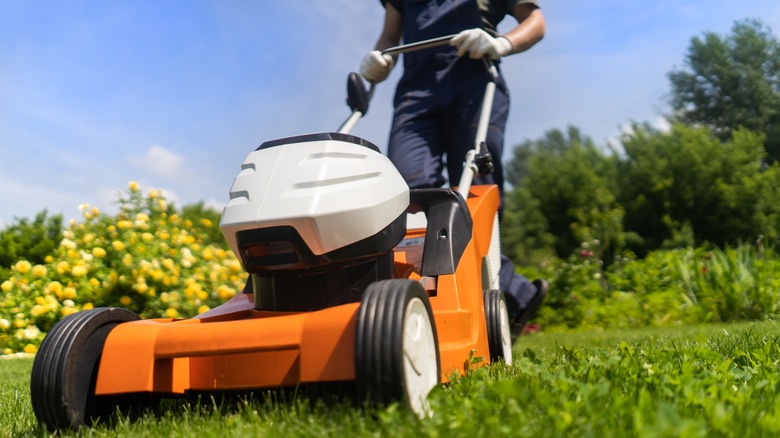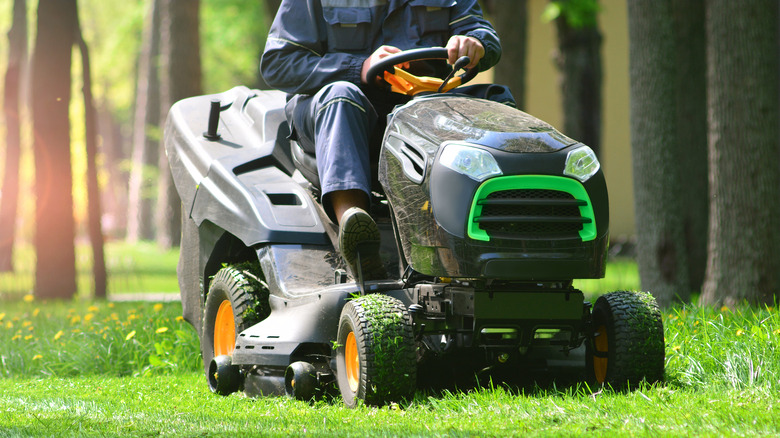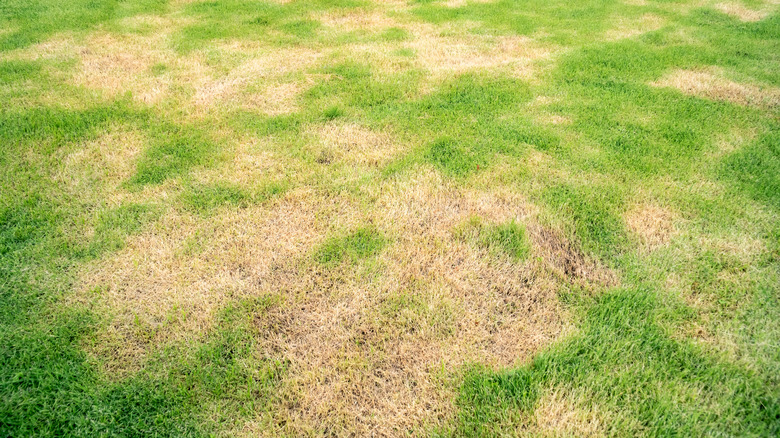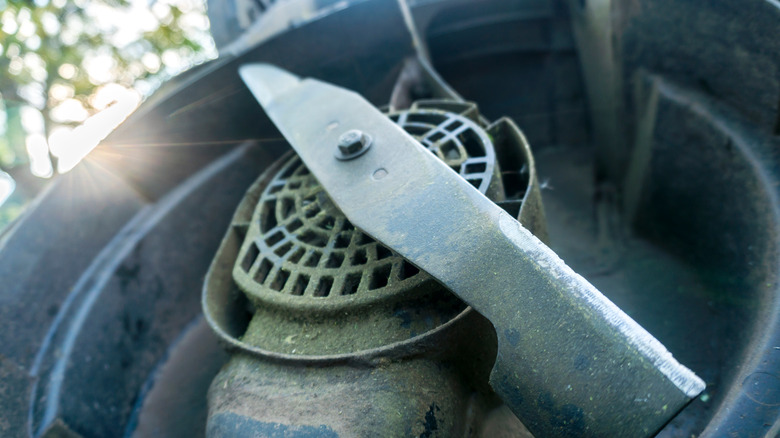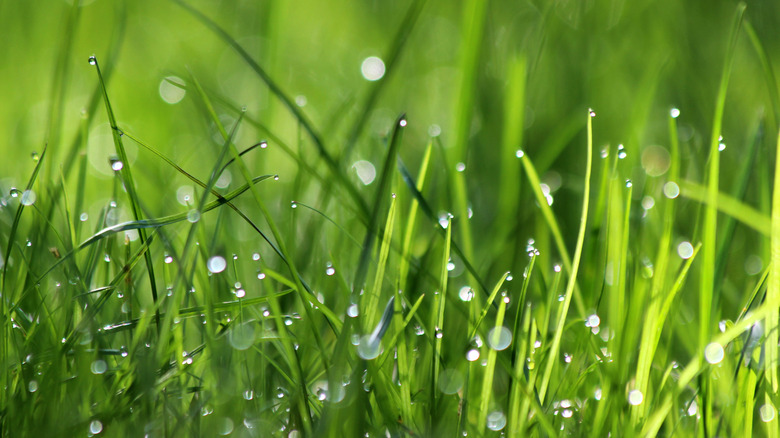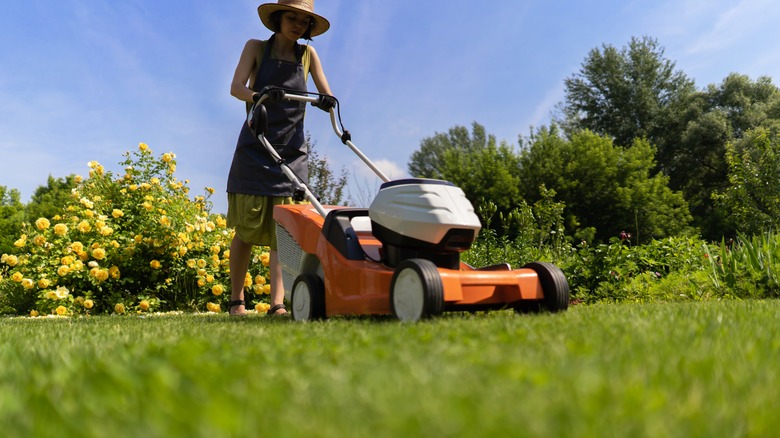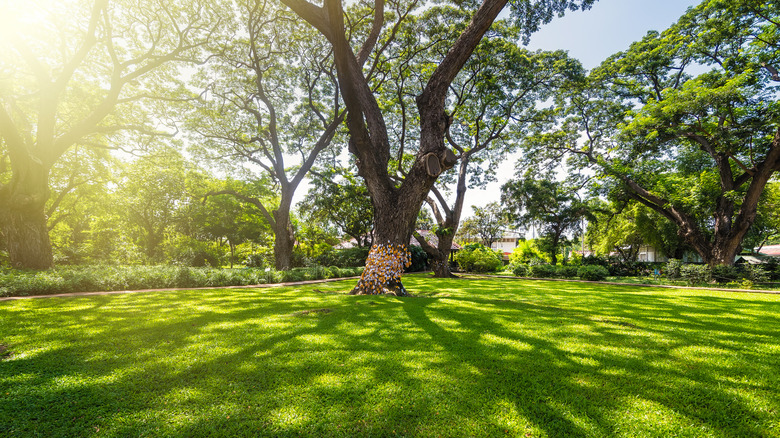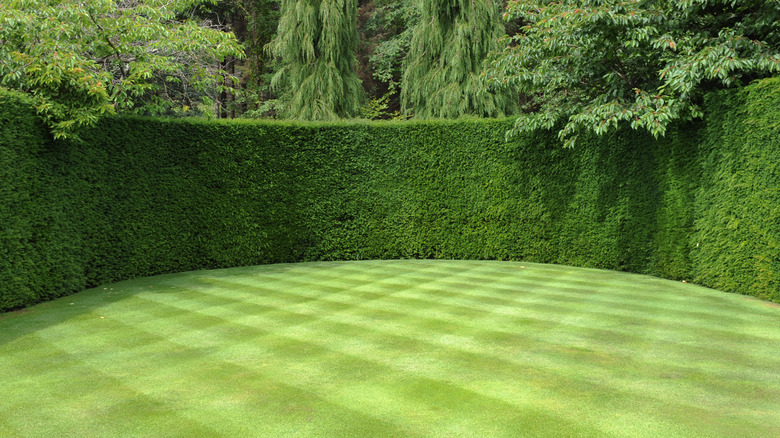7 Mistakes Everyone Makes When Mowing The Lawn
Summertime is busy for everyone. Between kids being out of school, gardening, sports, and the fear of missing out on great weather, there's always something going on. And just when it seems nothing else can fit on your to-do list, the grass starts to grow like crazy! Sometimes it feels as if you can stand outside and watch it grow.
Mowing the lawn is a nostalgic favorite for some and a dreaded necessity for others. But no matter how you look at it, everyone always makes a few mistakes when mowing the lawn. Unfortunately, often these are done without knowing they are wrong. Before you even mow the lawn, be sure the mower is clean and, depending on its condition, has seen the mechanic for a check-up, via Mom Does Reviews. After sitting in a shed over the winter, it will likely need some attention to ensure it's running well and safely.
1. Bagging up the grass
Mulching grass clippings instead of bagging them is the healthiest option for your lawn. The clippings from the grass will add nutrients to the soil and make for healthier grass, via Custom Lawn & Landscape Inc. It also helps it retains moisture which is especially important during the hot summer months when rain sometimes doesn't come often enough. And it's recommended to mow your lawn when 1⁄3 of the length of grass needs to be cut. If you're following this method, the size of grass clippings will be just the right size for easy composting.
But summers are busy, and it might be longer than you'd like if you haven't gotten around to cutting the grass. If the clippings are too big, you can quickly go back over them with the mower to chop them up. These smaller pieces of grass will soon decompose and add life to the soil.
2. Cutting grass too short
When grass is growing like crazy, it can feel like you have to mow the lawn multiple times a week to keep up. During this time, it might seem like a good idea to cut the grass extra short so you can catch a break. Realistically though, that choice will most likely result in unhealthy or dead grass. Cutting the lawn too short discourages photosynthesis because it reduces the surface area of each blade, and therefore, how much sunlight and oxygen they can each absorb. This is a problem that will continue all the way down into the root system and weaken the plant as a whole. A weakened plant is susceptible to drying out (hello, ugly brown patches), and then the entire yard has to work extra hard to grow back with limited resources.
At the end of the day, having a nice lawn means properly maintaining your grass. The quick fix you thought you were putting into place will likely cause more harm than good. This can translate into more time and work spent in the long run trying to nurse a suffering lawn back to health.
3. Using dull lawnmower blades
Cutting grass with a dull lawnmower blade is a common issue and one that needs to be addressed. The worn blade will rip and tear at the grass instead of creating clean cuts, and these rips make the grass more vulnerable to pests, diseases, and fungus. There are a number of signs that point toward a dull blade. First of all, does your lawn look uneven after a full pass with the mower? Or is it taking multiple passes or a longer time in general to finish? You probably have a lawnmower blade that's become too blunt to get the job done correctly.
From there, take a close look at the actual blades of grass. Are they jagged? Have they been pulled up in big clumps along with the underlying dirt? These are further signs of a blade that has been neglected for too long. Lawnmower blades should be sharpened by a professional twice per season or after any incidence of running over a rock. Proper blade maintenance will also alert you to any nicks, dents, or warping in the blades that you may have otherwise missed.
4. Cutting wet grass
Sometimes, it seems like the rain will never end throughout the season. It pours heavily and often, not allowing anything to dry out between showers. Of course, all that extra moisture is going to cause your very happy grass to grow out of control. But it's not a good idea to run out there for a quick cut the minute the rain finally stops. This is another practice that will likely cause more harm than good. As the wheels roll over wet grass they will slick and mat it down, making it impossible for even freshly sharpened blades to properly slice through them. The result is a lawn that looks patchy and unevenly cut.
Another issue with wet grass is that it will clump much easier and could clog up your mower and cause damage. Don't forget, too, that wet grass is slippery, making it risky if you head outside too soon. You could slip and fall, taking the mower down with you, causing injury or damage to your mower.
5. Cutting grass too quickly
Homeownership can feel like a never-ending to-do list so getting the grass cut can feel like a chore you've got to get done quickly. Before you try to achieve a fully mowed lawn in record time, stop for a minute and think it through. Just as with cutting the blades too short, a rushed cut will result in a messy and uneven job that will likely need to be redone anyway.
Mowing speed matters, and by this we mean the speed at which you push the mower. As proven by Smarter Every Day, with a video slowed down to 50,000 frames per second, a lawnmower blade is already moving at 200 miles per hour (via YouTube). This allows it to slice over and over to ensure an even finish. Furthermore, it has a tab on it that pulls up the grass blades so they all get cut at the proper height. Pushing the mower too fast across the lawn won't allow this complex system to cut the blades properly.
6. Mowing too often or not enough
Scheduling when and how often you mow will depend on what type of grass you have, what time of year it is, and how much sunlight and water your lawn receives. Anyone who experiences cold weather and frost will have a lawn that goes dormant in winter. When this happens, don't mow it even if you don't get much snow. During the warmer months try to pay attention to the environmental conditions at play. You know that a vegetable plant in your garden will grow better with higher amounts of direct sun exposure. Grass is a plant too, so the same is true for your lawn. Shaded areas under large trees won't grow as fast as sunny spots, so mow appropriately for each area.
Some grass species grow when the weather is warm — these include Bermudagrass, St. Augustine, and Zoysiagrass. Others, like Kentucky Bluegrass, tall fescue, and ryegrass thrive when temperatures cool off. Talk to a professional lawn care specialist to first learn what type of grass you have and then figure out exactly how often you should mow your lawn.
7. Always mowing in the same pattern
Grass isn't going to follow your commands no matter how nicely you talk to it. But you can end up inadvertently training your lawn if you repeatedly mow it in the same pattern. This can cause issues like soil compaction and blades of grass that no longer stand upright and lean to one side. The tires of the mower could also create trenches in the yard, meaning they could eventually cause bare spots. And no one loves a bear spot in the grass more than weeds do.
Save the integrity of your lawn by getting creative with the different kinds of patterns you can mow into it. Stripes, concentric circles, an oversized checkerboard that makes you feel like you're living on a royal lawn — really the possibilities are endless. That boring stretch of lawn in your backyard can be turned into a veritable work of art to show off your mowing prowess.
